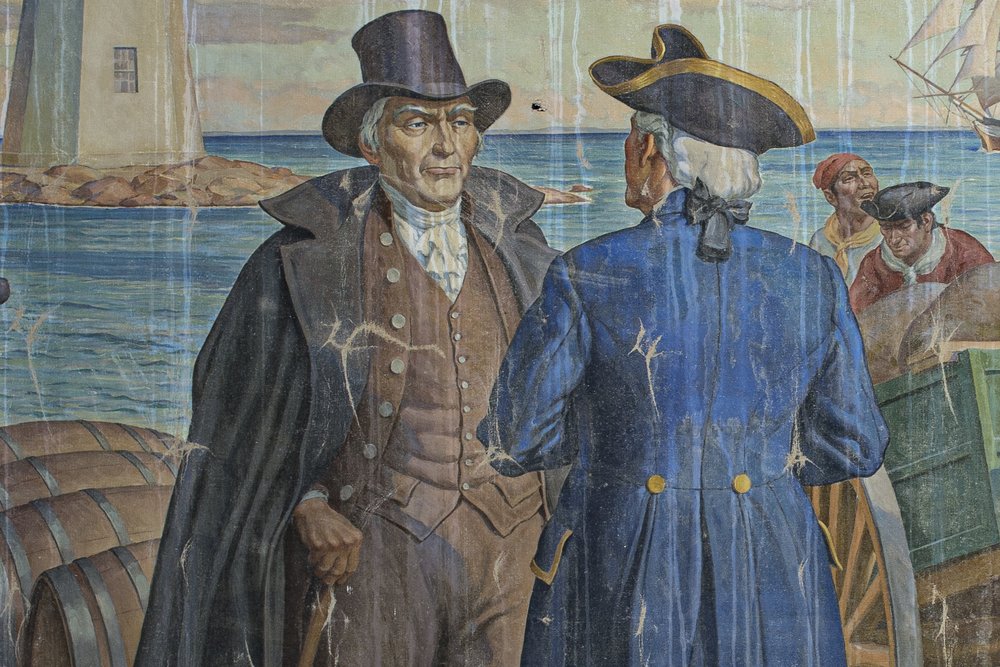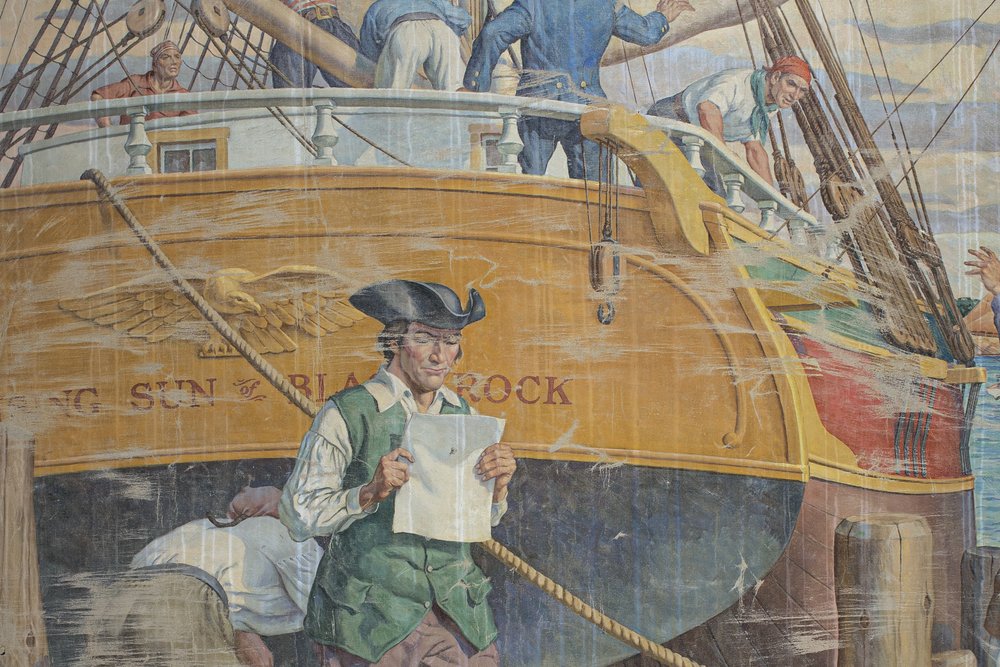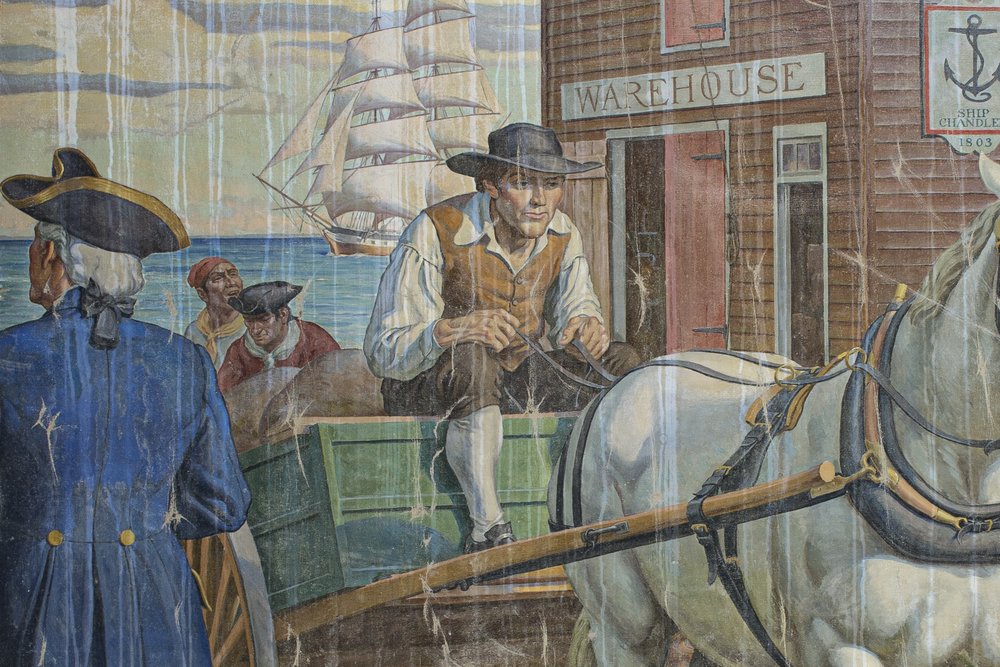MANAGING
MURALS
One of the great advantages of the Williamstown Art Conservation Center (WACC) is our ability to house and treat a variety of large-scale art works. Of these, a number of unfastened murals are seen stored on tubes throughout the building. I had the pleasure- albeit momentous task- of treating one such oversized painting. Old Black Rock Harbor About 1810 was painted in 1948 by Robert Lambdin, an oil on canvas mural that measures 8 feet tall by 20 feet wide. It belongs to the Fairfield Museum and History Center, where it is currently displayed in a newly-renovated gallery due to its historical significance and value to the community. This painting presented a unique set of challenges and sensitivities in addition to handling its oversized dimensions. While managing murals can be an overwhelming undertaking, much can be learned from the experience of assessing and treating such objects. Creative solutions and a great deal of teamwork were necessary to carry out and successfully complete the treatment.
The Condition
The mural was salvaged from a building renovation in Bridgeport, Connecticut. In a joint effort between the building’s new owner and the Fairfield Museum and History Center, Old Black Rock Harbor About 1810 (fig. 1) had been removed from its original wall-of-display in the former Black Rock Bank & Trust building. The mural was commissioned by the bank in the 1940s to celebrate local history- a commission won by homegrown artist, Robert Lambdin. Lambdin previously secured multiple New Deal commissions in the 1930s through the Works Progress Administration (WPA). After months of research in the Fairfield Historical Society, he composed an imagined maritime scene depicting early American life similar to those presented in other WPA-era murals [1]. The painting was deposited at the WACC in the summer of 2017 rolled on a tube, wrapped in plastic.
The weight of the de-installed canvas was a strong clue indicating one of the main challenges in handling and treating this mural: the presence of lead. Careful inspection of the painting confirmed the presence of lead-based adhesive on the verso. This layer had been used to mount the mural to the wall in the Black Rock Bank & Trust building. The use of lead white in thick pastes to adhere murals on walls was common practice from the twentieth century through the 1970s. The cavalier application of lead white, once prized for its strength and durability, is now a bane to many art conservators, posing a huge health risk and difficult material to mitigate. Associated to the lead-based adhesive, major damages to the canvas provided additional challenges and necessitated significant structural intervention. These issues originated from the de-install and are commonly seen in murals removed by mechanical force from solid supports. Rips and several lost fragments of canvas were noted throughout the fabric, created as workers fought against the lead-based adhesive that was steadfastly holding the mural to the wall. In order to release the painting, the canvas had been pulled at increasingly acute angles away from the wall, resulting in sweeping arcs of paint loss and abrasion across the surface. Aside from structural complications, treatment would also address the severe cosmetic issues present. Numerous fills and thorough inpainting would be necessary to reincorporate the aforementioned losses. Furthermore, a moderate grime layer, a heavily-yellowed, uneven varnish coating, and a pattern of drip marks disfigured the surface of the mural. The Black Rock Bank & Trust building had remained vacant for some time before being renovated, and it is estimated that leaks in the building created the overall drip patterns.
FIGURE 1 . Robert Lambdin, Old Black Rock Harbor about 1810, 1948, oil on canvas, 96"(H) x 240"(W) before treatment
The grime and varnish needed to be removed, and varnish removal tests were showing that the surface coating was particularly tenacious. The drip marks presented another complication for removing this surface coating, since they had eaten through the varnish and compromised the paint layer beneath. In addition to the affected portions of the paint layer, many pigments were sensitive to both aqueous and organic solvent solutions typically used for surface cleaning and varnish removal.
MANAGING MURALS
MARY HOLLAND | ASST. CONSERVATOR OF PAINTINGS
ART CONSERVATOR
DIGITAL
REFERENCES
[1]
Only in Bridgeport. “Fairfield Museum Rescues Historic Black Rock Mural”.
Accessible at:
http://onlyinbridgeport.com/wordpress/fairfield-
museum-rescues-historic-black-rock-mural/
[2]
HamletHub. "BOA Gifts 10K to Restore Black Rock Harbor Mural".
Accessible at:
https://news.hamlethub.com/fairfield/life/47615boa-gifts-10k-to-restore-historic-black-rock-harbor-mural[3]
For more technical information on the use of Evolon® in art conservation, see “Evolon CR: Its Use from a Scientific and Practical Conservation Perspective” by Gwen Tauber, Susan Smelt, Petria Noble, Kathrin Kirsch, Andreas Siejek, Katrien Keune, Henk Van Keulen, Saskia Smulders-De Jong, and Robert Erdmann in AIC Paintings Specialty Group Postprints, Vol. 31, 2018.
Click the arrows to view a larger details of the painting's condition
The Treatment
The degree and severity of issues in the painting’s condition presented no small task in rendering the mural exhibitable again. It became clear that some level of compromise would be necessary to reduce exorbitant costs for treatment, lower exposure risks to hazardous materials, and fit the museum’s deadline of a summer 2019 opening. After weighing the options, it was decided that the lead-based adhesive should be encapsulated through a full lining process rather than spend considerable resources on ablating the lead-white entirely. This would allow the labor to be split more evenly between structural and cosmetic work, assuring enough time be given to the complicated cleaning and extensive retouching. A proposal was generated, and so began a year-long fundraising campaign by the Fairfield Museum and History Center to acquire income for treatment. Through generous gifts from museum donors, The Bank of America, and a GoFundMe page, treatment was funded and work began on the mural in the fall of 2018 [2].
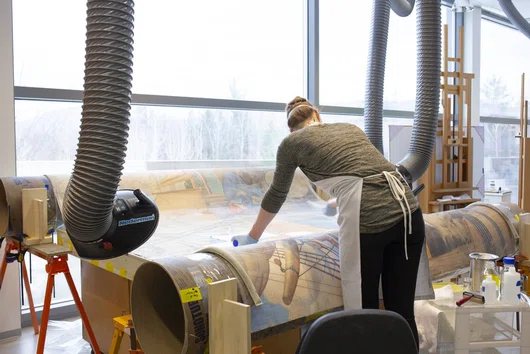
FIGURE 2 . Set-up of “scrolling” system used to support the mural during surface cleaning
Once the BEVA® 371 solution solidified on the mural the lead no longer posed an immediate health hazard and surface cleaning could begin. Paint layer sensitivities detected during the initial assessment occurred in part because of the repetitious mechanical action conservators typically use to apply aqueous solutions and organic solvents: rolling a cotton swab. An innovative technique using Evolon® AP permitted the use of a tailored cleaning solution by limiting contact with the compromised paint film, enabling a passive removal of grime and varnish. Evolon® AP is an extremely absorbent, non-woven, microfiber “paper” made out of a polyester/nylon mix. This paper is placed on the surface and saturated with solvent; through capillary action, the solvent solubilizes the grime and varnish which are then gently wicked up through the Evolon® AP. The use of Evolon® AP was crucial in facilitating the cleaning process, protecting the paint layer while removing the offensive materials [3].
The size of the mural hindered the physical task of accessing the surface for cleaning; this demanded us to invent a simple, semi-permanent set-up in the studio. A “scrolling” system was created by staging two Sonotubes® on sawhorses with a table between, acting as a support for the mural (fig. 2). The Sonotubes®, one containing the mural and the other empty, were secured on the sawhorses by simple wooden braces that butted against either side of the tubes on each end. These wooden braces were mounted onto the sawhorses with clamps, making them easily adjustable. This allowed the mural to be unrolled and cleaned in sections, re-rolling the cleaned portions onto the second Sonotube® and continuing cleaning in the newly unveiled and sullied section of the mural. The task of unrolling and re-rolling needed at least four bodies working in unison; one person on either end of each tube. This assured a safe and controlled manipulation of the mural. The entire surface cleaning took nearly two months to complete, a regimented process carried out in a grid pattern (figs. 3a-3b). Simultaneously, any areas of vulnerable paint encountered during the cleaning were locally consolidated to prevent further damage.
Encapsulating the lead-based adhesive was our first priority as treatment commenced; prior to this it was important to restrict handling of the mural as much as possible to reduce exposure to the toxic lead. Hazardous material protocol was followed, requiring our team to suit up as necessary whenever handling the mural. After photographic documentation, the rolled mural was placed on our eight feet by twelve feet hot table, the largest continuous surface available. As the twenty-foot-long mural tested our spatial limits, a systematic unrolling of the mural in sections was necessary while addressing the lead-based adhesive. The reverse of the mural was repeatedly cleaned with a HEPA-filtered vacuum in order to remove any loose fragments of lead-based adhesive and these particles were contained for lead-waste removal.
The verso was then sealed with diluted BEVA® 371 solution, a proprietary adhesive based on ethylene-vinyl acetate (EVA) copolymers formulated exclusively for art conservation. This material was chosen for multiple reasons, the most important of which are its ability to fully encapsulate the lead-based adhesive and its bond strength to withstand the forceful weight of the mural. The thermoplastic quality of BEVA® 371 solution allows the dried adhesive to be re-activated when exposed to heat; therefore, impregnating the reverse of the canvas with the liquid solution simultaneously encased the lead-based adhesive and prepared the painting for the full lining process, which would take place after grime and varnish removal.
FIGURE 3A. Mary Holland utilizing a tailor-made method for surface cleaning. Evolon® AP was cut into manageable-sized sheets and pipette-soaked with the appropriate solvent solution.
FIGURE 3B. The Evolon® AP solubilized the grime and varnish through capillary action without negative consequence to the sensitive paint layer.
After the mural was cleaned, the lining was carried out. A heavy-weight, plain-weave linen was chosen as the lining fabric primarily because the bolt was large enough to cut one continuous piece of fabric for the process. Structurally, the heavy-weight fabric would act to support the canvas which had been weakened by the heavy lead-based adhesive, and create tacking margins to allow the painting to be mounted on an auxiliary support. The lining canvas was attached to an oversized working strainer; this set-up took over the majority of floorspace in our technician’s packing area. The raw linen was sized with diluted BEVA® D-8 adhesive, an aqueous dispersion of EVA. The cleaned mural was then rolled-out, face-down, and the prepared linen was secured to the mural verso using BEVA® Gel, another aqueous dispersion of EVA and resins. The use of multiple, thin layers of thermoplastic BEVA® adhesives in conjunction assured compatibility and provided the required strength needed to successfully attach and support the mural.
FIGURE 4 . Conservators Mary Holland and Montserrat Le Mense during the inpainting campaign of Old Black Rock Harbor About 1810
The lining fabric margins were released from the working strainer, the mural was re-rolled and brought back into the Paintings Studio to complete the heat lining. This final step was split into three sessions on our large hot table under vacuum pressure, using the heat to fully activate and set the BEVA® adhesives while the vacuum pressure created an even attachment between the painting and lining canvas. Lining complete, the mural was mounted to a custom-built stretcher manufactured by Simon Liu, Inc. Finally, for the first time throughout the treatment, the entirety of
Old Black Rock Harbor About 1810
was able to be viewed at once. It is always anxiety-inducing when one cannot see the whole painted surface during treatment, but the methodical and careful approach undertaken throughout the process of treating this mural lent a level of confidence up to this big reveal. The mural was set up against a continuous wall facing northern light to provide the best natural sunlight for the cosmetic steps of treatment. An overall application of stable synthetic varnish added a layer of protection and splendidly saturated the paint layer. The typical tools employed to apply varnish to easel paintings- a spray gun powered by an air compressor in a spray-booth- could not be used for the mural due to the spatial limits of our building.The mural could not be brought outside for varnishing with a spray gun due to uncooperative spring weather. The fast-approaching deadline demanded action, therefore, it was decided to varnish the mural by hand with a large Omega Lily varnish brush. The chosen synthetic resin, Paraloid™ B-72, was put into a 20% (w/v) solution using a very slow drying aromatic solvent blend, Shell Cyclosol 53®. This varnish solution was successfully applied by brush and evenly worked across the surface because of the extended working window provided by the slow evaporation rate of the solvent. The varnish layer also acts as a barrier for the original paint layer against the fill material and reversible retouching applied to reincorporate paint loss. Dramatic sweeps of paint loss required constant reference to intact passages of the composition to inform inpainting fragmented details (fig. 4).
FIGURE 5 . Hugh Glover, retired conservator of furniture and frames, fits the frame onto the painting with our conservation technician, Paul Nichols. The frame was custom-made at the Williamstown Art Conservation Center.
With the deadline looming, a custom maple frame (fig. 5) was attached to the edges of the mural and the last daub of retouch met the surface. After years of anticipation, Old Black Rock Harbor About 1810 was ready to be transported to its new home in the Fairfield Museum and History Center and unveiled to the public (fig. 6).
FIGURE 5 .
Old Black Rock Harbor about 1810
, after treatment and framing